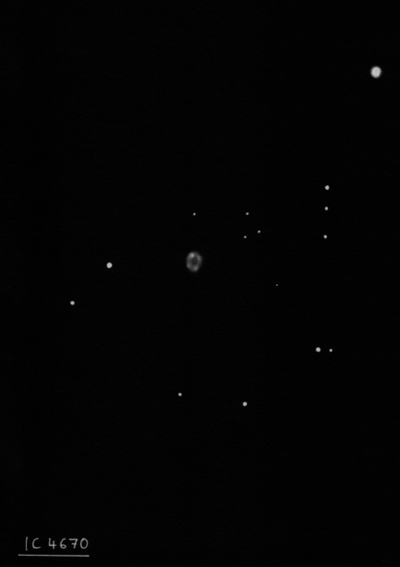
Joseph Lunt discovered IC 4670 visually in 1901 with the Cape Observatory 24-inch refractor (the "Victoria Spectroscopic Telescope" erected in 1898) fitted with an object-glass prism. He described it was stellar and mag 12-13 and situated "immediately S.f. C.P.D. -21[deg] 6502". He noted "The nebula is 2.5 seconds preceding a slightly brighter star of the same declination." It was also photographed on 2 plates in 1901. Although his position is 3.5' too far south, the identification is certain.
Hubble reported IC 4670 as a new planetary after it was found on plates taken in 1920 with a 10-inch Cooke Astrographic Lens with objective prisms attached. The equivalence with IC 4670 was not noticed by the ESO catalogue (1982). Kent Wallace reported IC 4670 = Hb 6 in 1990.
300/350mm - 13.1" (7/12/86): at 79x, faint, stellar, verified with OIII blinking. A mag 11 comparison star is 2.0' NW. At 166x a very small disc is visible which is brighter at the center. The disc is quite clear at 214x, estimate V = 12.5-13.0.
400/500mm - 17.5" (3/20/93): at 220x appears moderately bright (estimate V = 12-12.5) and a very small disc is clearly visible. Good response to an OIII filter. Appears brighter than a mag 13 star 40" E and just fainter than a mag 11.9 star 2.9' E. A double star mag 9.6/11.2 at 7" in PA 163° is 5' SSE.
Notes by Steve Gottlieb